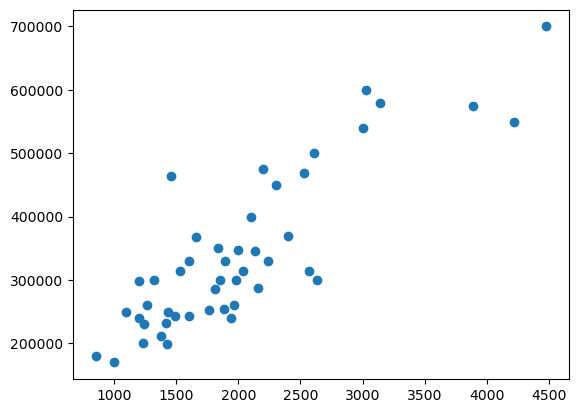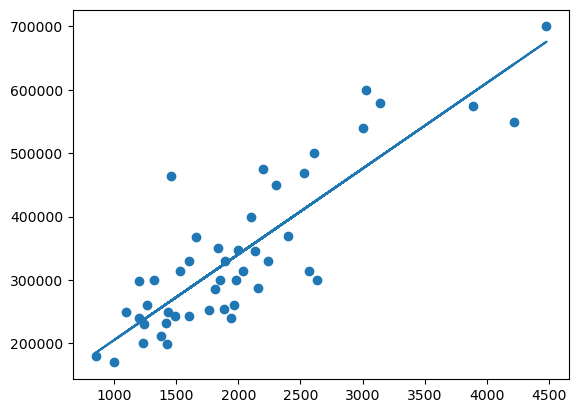代码课1.1(线性回归,穷举参数)
先导入有关模块
# import annotations
from __future__ import annotations
# import time to calculate the program running time
import time
# import numpy, using narray to store the data.
import numpy as np
# import matplotlib to draw figures
import matplotlib.pyplot as plt
定义 模型结构 与 损失函数
本质上就是用代码去描述一遍数学表达式
# create the model
def f(w: float, x: ArrayLike, b: float) -> ArrayLike:
y_hat = np.array([])
for i in x:
p = w*i+b
y_hat = np.append(y_hat, p)
return y_hat
# create the cost function
def squaredErrorCost(y: ArrayLike, y_hat: ArrayLike) -> float:
m = y.size
err = y_hat - y
cost = np.dot(err, err)
cost = cost.sum()/(2*m)
return cost
养成良好的习惯,写好函数后,编个简单的测试用例,进行检验。不然以后要 Debug 就不容易了。
# Simply verify the written function
x = np.array([1, 2, 3, 4])
y = np.array([2, 4, 6, 7])
y_hat = f(2, x, 0)
J = squaredErrorCost(y, y_hat)
print(f"The predictions {y_hat}, the cost {J}")
The predictions [2. 4. 6. 8.], the cost 0.125
导入数据集合,数据集可以去网上下载,也可以自己编写。
# import datas
data = np.loadtxt(fname="../data/data.txt", delimiter=',')
# create training examples
x = data[..., 0]
y = data[..., 2]
数据导入完毕后,将其可视化。经观察发现,数据确实存在一定的线性关系,可以用来训练线性回归模型。
数据可视化(data visualization) 是个非常重要的技能,它能辅助我们选择合适的模型,判断模型训练情况等。下期,我们将重点介绍这个。
plt.scatter(x, y)
<matplotlib.collections.PathCollection at 0x75d4050f8410>

准备工作完成之后,我们就可以通过一定的算法来训练模型了。由于我们现在只会穷举,就先将就着用吧,主要目的在于体验这个过程。以后,我们通过不断学习,逐步优化我们的训练代码。
基于现有的知识,寻找合适的解决方案,不失是一种智慧。
我们遇到的问题是:算力不够,时间有限,不可能枚举所有的 w,b。
解决方案:依照数据集,先给定一个合理的 w,b 范围。再依据训练得到的反馈,手动修正范围,逐步获得优化的 w,b。
操作:
- 先从 (100,600) 中等间隔取 100 个数作为 w,从 (10000,20000) 中等间隔取 100 个数作为 b;
- 运行后发现,b=10000;
- 将 b 范围调整为 (0,10000) 继续尝试与调整;
- 感觉 J 值合理,停止操作。
以下给出 w (100,600),b (0,10000) 时的情况
# Because we haven't learned gradient descent,
# we can only use exhaustion method first.
# Let's just have a try for fun.
start = time.time()
J_hist = []
for w in np.linspace(100, 600, 100):
for b in np.linspace(0, 100000, 100):
y_hat = f(w, x, b)
J_hist.append((w, b, squaredErrorCost(y, y_hat)))
J_hist.sort(key=lambda x: x[2])
w = J_hist[0][0]
b = J_hist[0][1]
cost = J_hist[0][2]
end = time.time()
print(f"w:{w}, b:{b}, J:{cost}, running time:{end-start}")
w:135.35353535353534, b:69696.9696969697, J:2058348241.0833101, running time:2.1354281902313232
我们吃惊地发现,J 值竟然有 20 亿!不用害怕,由于我们的模型过于粗糙,今后学习了梯度下降,特征缩放,特征工程等后,我们会逐步把 J 压下去的。
你可能想增大等间隔取的参数个数,来获得更优模型,下面的代码,可以给我们带来一些思考。
start = time.time()
J_hist = []
for w in np.linspace(100, 600, 1000):
for b in np.linspace(0, 100000, 100):
y_hat = f(w, x, b)
J_hist.append((w, b, squaredErrorCost(y, y_hat)))
J_hist.sort(key=lambda x: x[2])
w = J_hist[0][0]
b = J_hist[0][1]
cost = J_hist[0][2]
end = time.time()
print(f"w:{w}, b:{b}, J,:{cost}, running time:{end-start}")
w:134.53453453453454, b:71717.17171717172, J,:2058240962.6992188, running time:19.46424102783203
很明显,J 并没有减少多少,但运行时间却增加了 9 倍。
或许,并不是我们的 w,b 不合理,而是利用线性模型 J 值就小不了。但这不是说线性模型无能,今后通过对线性模型的包装,我们是能够将 J 值降到很小的。
下面的图像现实,我么们的 w,b 取的并不差。
y_predit = f(w, x, b)
plt.scatter(x, y)
plt.plot(x, y_predit)
plt.show()

不过,为了获得最适合的 w,b 值,以及解决一些更复杂的 w,b 取值问题,我们有必要了解梯度下降算法。即使我们知道,对于今天的问题,就算用梯度下降算法,或许也无济于事。






















 2028
2028

 被折叠的 条评论
为什么被折叠?
被折叠的 条评论
为什么被折叠?








